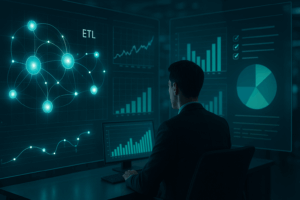IOblend and Streamsets are both advanced data integration platforms that cater to the growing needs of businesses, especially in real-time analytics use cases. While there are similarities, they also bring different features to the table. Here’s an overview of their capabilities:
Real-time Data Integration
IOblend:
- Supports real-time, production-grade data pipelines using Apache Spark with proprietary tech enhancements.
- Can integrate equally streaming (transactional event) and batch data due to its Kappa architecture with full CDC capabilities.
Streamsets:
- Designed to handle streaming data with native support for change data capture (CDC) and supports both real-time and batch processing.
Low-code/No-code Development
IOblend:
- Provides low-code/no-code development, facilitating quicker data migration and minimization of manual data wrangling.
Streamsets:
- Features a drag-and-drop interface for designing data pipelines and also supports scripting for more intricate requirements.
Data Architecture
IOblend:
- Enables delivery of both centralized and federated data architectures.
Streamsets:
- Offers a flexible architecture allowing for both centralized and decentralized data operations.
Performance & Scalability
IOblend:
- Boasts low-latency, massively parallelized data processing with speeds exceeding 10 million transactions per second.
Streamsets:
- Optimized for performance in large-scale environments and supports various scalability configurations to handle growing data loads.
Partnerships & Cloud Integration
IOblend:
- Has real-time integration capabilities with Snowflake, AWS, Google Cloud and Azure products and is an ISV technology partner with Snowflake and Microsoft.
Streamsets:
- Provides integration with major cloud platforms including AWS, Azure, Google Cloud, as well as other platforms and data stores.
User Interface & Design
IOblend:
- Consists of two main components: IOblend Designer and IOblend Engine, facilitating design and execution respectively.
Streamsets:
- Offers a singular, intuitive platform called Streamsets Data Collector, tailored for designing, deploying, and monitoring data pipelines.
Data Management & Governance
IOblend:
- Ensures data integrity with features like automatic record-level lineage, CDC, SCD, metadata management, de-duping, cataloguing, schema drifts, windowing, regressions, eventing, late-arriving data, etc. integrated in every data pipeline.
- Connects to any data source via ESB/API/JDBC/flat files, both batch and streaming (inc. JDBC) with CDC (supports all three log, trigger or query based).
Streamsets:
- Prioritizes data drift management, ensuring pipeline robustness against changes in data, infrastructure, and schemas. Also has strong monitoring capabilities.
- 100+ pre-built connectors to all major data sources
Cost & Licensing
IOblend:
- The Developer Edition is free, while the Enterprise Suite requires a paid annual license.
Streamsets:
- Offers a free community version and premium versions with added functionalities and support.
Deployment & Flexibility
IOblend:
- Operational on any cloud, on-premises, or in hybrid settings. Comes in Developer and Enterprise Editions.
Streamsets:
- Supports deployment in cloud, on-premises, and edge devices, ensuring flexibility in data operations.
Community & Support
IOblend:
- Being relatively new, its community is still burgeoning. Provides online support for Developer Edition and premium support for Enterprise Edition.
Streamsets:
- Sports a vibrant community providing resources, plugins, and assistance. Premium support is also available for enterprise-grade users.
To sum up, while IOblend places emphasis on real-time data integration and low-code solutions, Streamsets is tailored for handling streaming data with an emphasis on data drift management. Choosing between them would rest on the specific requirements, infrastructure, and objectives of an organization.

Real-Time Risk Modelling with Legacy & Modern Data
Risk Modelling in Real-time: Integrating Legacy Oracle/HP Underwriting Data with Modern External Datasets 💼 Did you know that in the time it takes to brew a cup of tea, a real-time risk model could have processed enough data to flag over 60 million potential fraudulent insurance claims? The Real-Time Risk Modelling Imperative Real-time risk modelling is

Unify Clinical & Financial Data to Cut Readmissions
Clinical-Financial Synergy: The Seamless Integration of Clinical and Financial Data to Minimise Readmissions 🚑 Did You Know? Unnecessary hospital readmissions within 30 days represent a colossal financial burden, often reflecting suboptimal transitional care. Clinical-Financial Synergy: The Seamless Integration of Clinical and Financial Data to Minimise Readmissions The Convergence of Clinical and Financial Data The convergence of clinical and financial

Agentic Pipelines and Real-Time Data with Guardrails
The New Era of ETL: Agentic Pipelines and Real-Time Data with Guardrails For years, ETL meant one thing — moving and transforming data in predictable, scheduled batches, often using a multitude of complementary tools. It was practical, reliable, and familiar. But in 2025, well, that’s no longer enough. Let’s have a look at the shift

Real-Time Insurance Claims with CDC and Spark
From Batch to Real-Time: Accelerating Insurance Claims Processing with CDC and Spark 💼 Did you know? In the insurance sector, the move from overnight batch processing to real-time stream processing has been shown to reduce the average claims settlement time from several days to under an hour in highly automated systems. Real-Time Data and Insurance

Agentic AI: The New Standard for ETL Governance
Autonomous Finance: Agentic AI as the New Standard for ETL Governance and Resilience 📌 Did You Know? Autonomous data quality agents deployed by leading financial institutions have been shown to proactively detect and correct up to 95% of critical data quality issues. The Agentic AI Concept Agentic Artificial Intelligence (AI) represents the progression beyond simple prompt-and-response

IOblend: Simplifying Feature Stores for Modern MLOps
IOblend: Simplifying Feature Stores for Modern MLOps Feature stores emerged to solve a real challenge in machine learning: managing features across models, maintaining consistency between training and inference, and ensuring proper governance. To meet this need, many solutions introduced new infrastructure layers—Redis, DynamoDB, Feast-style APIs, and others. While these tools provided powerful capabilities, they also
